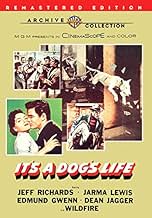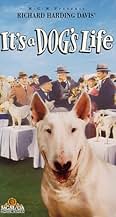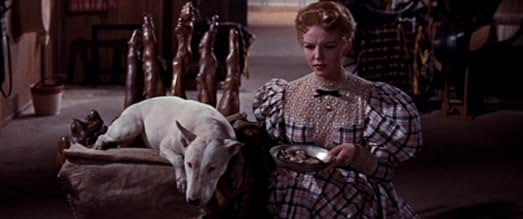Ajouter une intrigue dans votre langueA bull terrier tells his life story, from the streets of the Bowery to a life of luxury.A bull terrier tells his life story, from the streets of the Bowery to a life of luxury.A bull terrier tells his life story, from the streets of the Bowery to a life of luxury.
- Réalisation
- Scénario
- Casting principal
- Paddy Corbin
- (as J. M. Kerrigan)
- Bar Patron
- (non crédité)
- Bar Patron
- (non crédité)
- Dog Catcher
- (non crédité)
- Bar Patron
- (non crédité)
- Dogcatcher with Net
- (non crédité)
- Citizen
- (non crédité)
- Dog Owner
- (non crédité)
- Carney
- (non crédité)
- Bettor at Contest
- (non crédité)
Avis à la une
The original story was based on something that famed nineteenth century newspaper correspondent Richard Harding Davis wrote. When he was not covering things like the Spanish American War, Davis took his hand at fiction. He wrote the Gallegher stories that Walt Disney filmed during the Sixties with Roger Mobley.
This is the rags to riches story of a stray dog who managed to get from fighting dog of the Bowery to pampered show dog on Long Island. As Vic Morrow who supplies the dog's voice and does the narration, Horatio Alger would have loved this story. He certainly would have because Horatio was writing his stuff during this same time.
Of the human actors we have to single out Edmund Gwenn and Dean Jagger, two of the most accomplished character actors around. Gwenn as the groom and stableman on Jagger's estate and Jagger as the wealthy dog breeder who has a lot of issues in a lot of areas both are just fine in the roles. And they don't let the appealing little canine steal the scenes either.
I wish I could rate this film better, but sad to say I know all too well that dogs who are bred as killers are not likely to change their ways and become show dogs. Maybe Davis could sell that as fiction in his time and maybe MGM could see it in 1955, but it doesn't go over today.
Still some may find this a cute film.
The movie itself, on finally seeing it again as an adult, is not nearly as bad as some reviewers would have you think. From my point of view, it doesn't condone dog-fighting, nor even abuse of women. Sure, it shows some fairly unacceptable behaviour, but I didn't get the impression that this was being shown as an example of the behaviour on which our own should be modelled. When I think how many times in my viewing history I've seen people (not necessarily women) punched, kicked, shot, tortured, and murdered in cold blood, then this movie is pretty darn tame.
Since buying the DVD, and then buying the book on which this movie was based (yes, this movie made a huge impression on the child who saw it years ago), I still think it's a good movie. Clunky, sure. A little strange sometimes - absolutely. Displays outmoded behaviours - no argument. But still, for Wildfire alone, worth a view or two.
After setting up the dog as its central character, the movie introduces Jeff Richards and he temporarily takes over the story. Then he disappears and Edmund Gwenn belatedly enters the plot and the story begins to center around him. And then Jeff Richards comes back! Few movies have had such a shifting focus as this one. And why pick a bull terrier since this breed doesn't have the expressive eyes into which audiences can project all sorts of emotions? The bull terrier's blank look often seems at odds with the narration being spoken for him by actor Vic Morrow.
Perhaps most curiously, while this might have been designed as a movie with a special appeal to children, there are no children in it! In fact, two of the main characters are decidedly in the "senior citizen" class: Edmund Gwenn and Dean Jagger.
And yet ... the movie has a certain charm. Its early 1900s setting is pleasantly, though superficially, mounted. The cast is attractive, there are no slow spots in the story, and the whole thing's wrapped up in less than 90 minutes. Those who've seen the movie always seem to remember it, even though some of these memories may now be approaching 50 years in age.
Jeff Richards seems a bit miscast, (he doesn't have a tough-enough edge), but this is still one of his better parts at a time when he appeared to be moving toward stardom. For some reason or other, he never "clicked" and soon faded from view. Here he has a scene without his shirt, showing off the kind of chest hair which other actors shaved, and he looks lip-smackin' good! For even more footage of Jeff's chest, though in black-and-white, check out "Island of Lost Women."
Le saviez-vous
- GaffesWhen Patch first encounters Wildfire at the bar, he takes him over and places him on a table. The dog is then shown sitting and standing in subsequent successive shots.
- Citations
[first lines]
Wildfire: [about him and his mother as they wander the streets and back alleys of the Bowery] We ate at only the best restaurants in the waterfront o' little old New York. Well, behind the best restaurants anyway. Hoffmeier's garbage can belonged to me and my mother. Everybody knew that. That's Ma, working on a steak bone. As for those mongrels, thinking they were going to push us out of the way, that was a large mistake. Although I do not admire the expression, it was strictly dog eat dog on the waterfront.
- Crédits fous[prologue] "I agree with Agassiz that dogs possess something very like a conscience." Charles Darwin, The Descent of Man.
- ConnexionsReferenced in My Three Sons: It's a Dog's Life (1965)
Meilleurs choix
Détails
Box-office
- Budget
- 891 000 $US (estimé)
- Durée
- 1h 28min(88 min)
- Rapport de forme
- 2.55 : 1


































